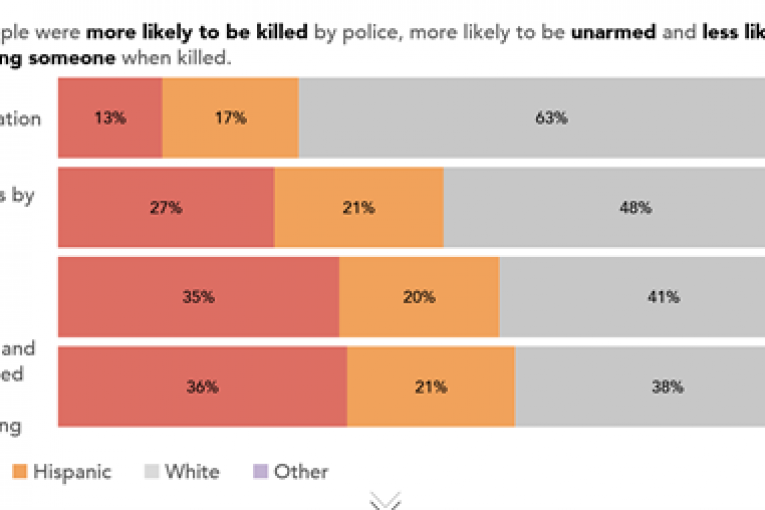

By Max Kennedy
NATIONAL – More than 1,100 people were killed by police in 2020, according to the 2020 Police Violence Report (https://policeviolencereport.org/) from Mapping Police Violence, an organization which tracks killings by law enforcement in the U.S.
The report–built in the form of an interactive website–relies on data compiled from media reports, public records and third-parties like Fatal Encounters and the Washington Post’s Fatal Force database.
This data helps Mapping Police Violence dig into patterns and trends over time in alleged police killings.
For example, the report notes that just one percent of officers are charged as a result of these killings, and most killings began with officers responding to suspected non-violent offenses.
The report also reveals that people of color, particularly Black people, are significantly more likely to be killed by police officers than are white people. A Black person in the US is more than 2.5 times as likely to be killed by police compared to a white person, and is more likely to be unarmed when killed, according to the report. Hispanic people, too, face higher rates of  police killings compared to white people.
police killings compared to white people.
In a country still reeling from George Floyd’s death last May, these numbers are likely to add to ongoing debates around police bias, police use of force and the killings of unarmed black men.
80 people killed by police in 2020 were unarmed, according to the report, and 65 people were considered “armed with a vehicle.” 670 were allegedly armed with a gun, and 180 with a knife or sharp object.
The report also notes that most killings by police in 2020 resulted from situations where there were no initial allegations of threatening firearm use.
Ninety-four killings came from mental wellness checks, 121 from traffic stops, and 411 from other situations where the victim was not alleged to be threatening violence with a firearm. “Creating alternative responses to these situations could substantially reduce this violence nationwide,” notes the report.
Other highlights from the report:
- 96% were killed by police shootings. Tasers, physical force, and police vehicles accounted for most other deaths.
- Of identified officers in 444 cases, at least 14 had shot or killed someone before. 5 had multiple prior shootings.
Mapping Police Violence was founded in 2015 “to find, analyze and evaluate every case where a person is killed by police in the United States,” according to founder and activist Samuel Sinyangwe.
“Law enforcement agencies across the country have failed to provide us with even basic information about the lives they have taken,” reads the Mapping Police Violence website.
“We hope this data will be used to provide greater transparency and accountability for police departments as part of the ongoing campaign to end police violence in our communities,” the website noted.
 Max Kennedy graduated from Harvard in 2016 with a degree in History. He is an intern with the San Francisco Public Defender and most recently worked as a digital organizer with Joe Biden for President.
Max Kennedy graduated from Harvard in 2016 with a degree in History. He is an intern with the San Francisco Public Defender and most recently worked as a digital organizer with Joe Biden for President.
To sign up for our new newsletter – Everyday Injustice – https://tinyurl.com/yyultcf9
Support our work – to become a sustaining at $5 – $10- $25 per month hit the link:





Thanks for the timely article. This provides some numbers to flesh out at the national level the local experiences discussed in our recent League of Women Voters forum and currently being addressed in our city’s Adopt the Nine initiative.
I’m glad you made this connection because this is an issue that cuts from national to local and then needs to be addressed at multiple levels.
Pales in comparison to citizens killing each other (unlike many police killings, meeting the definition of murder, apparently). Approximately 15,500 murders in 2018, alone.
https://en.wikipedia.org/wiki/Crime_in_the_United_States#:~:text=In%202018%2C%20the%20US%20murder,a%20total%20of%2015%2C498%20murders.
So, regardless of skin color, the wording of this seems to describe an “execution”. Is that how this is to be interpreted?
That may be true, but there are several factors here. One is that when a police kills someone, it is the state killing them. The second is that we have a system of justice for people who kill other people (assuming we catch them which is an under-recognized problem). We don’t have an effective system of justice for when police kill people.
Again, the article (almost) implies that the police are executing people.
Of the 1,100 killed by police (comprising all skin colors), how many is the article alleging were executed?
I think the correct interpretation is that the 2020 Cop Violence Report is suggesting that the policing of unarmed people is unjustified. I think if you wish to answer your question, digging into the report may be beneficial.
Why do you keep using the term “executed?” They were killed.
You might be able to infer that number by looking at the chart at the top – unarmed and not alleged to be threatening and calculate the number from the 1100 figure.
The reason I keep using the term “executed” is because that’s a logical conclusion, if the police are killing those “unarmed and alleged to be non-threatening”.
In any case, how many total is that (of the 1,100)? And, “who” is doing the alleging?
.
It is a conclusion … but whether it is logical or not is subject to discussion. I might even call it a supposition rather than a conclusion … or possibly “reading between the lines.”
Should be noted, they did not use the term executed.
They did find: “Our analysis suggests the majority of killings by police in 2020 could have been prevented and that specific policies and practices might prevent police killings in the future.”
Do you disagree with this finding Ron Oertel?
I don’t know if I agree, or not. I’m sure that some could have been avoided.
But, I’d like to know the actual number of those killed in allegedly-questionable circumstances. (With the latter likely not clearly defined.)
And again, I’d like to know “who” is doing the alleging. Defense attorneys and advocacy organizations may not be the ones to totally rely upon, regarding that. The article itself uses wording that causes me to doubt its objectivity.
Unlike you, they did the analysis of the incidents.
“But, I’d like to know the actual number of those killed in allegedly-questionable circumstances. ”
If you look at the chart at the top, you can calculate it.
I am seeing the following, out of the 1,100 killed. (However, the quote itself does not add up to the 1,100 as listed elsewhere in the article.)
So, out of the 80 (which I assume are the ones determined to be allegedly non-threatening), we can then break it down (approximately) by skin color (using the chart in the article):
30 were white
29 were black
17 were hispanic
4 were “other”
(My fifth and final comment.)
The others they probably don’t have data on.
Well then, if one does an analysis, that says it all 😐